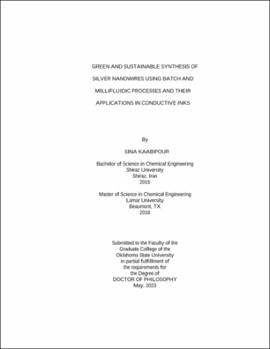| dc.description.abstract | This dissertation focuses on the solution-based synthesis of one-dimensional (1D) silver nanostructures (mainly silver nanowires) using green, sustainable, and cost-efficient materials and processes, and application of 1D silver nanostructures in conductive inks formation for printed circuit boards (PCBs) application. Conventional chemical and physical processes used for the synthesis of metallic nanostructures, in general, suffer from hazardous waste production, usage of unsustainable reagents, high energy consumption, and high production cost. However, recent research proves that plant-based products such as polyphenols can serve as proper alternatives (as the reducing/capping/stabilizing agents) to produce nanostructures with different sizes and morphologies, if the process parameters are controlled properly. In such processes, hazardous waste production can be significantly limited if not eliminated, and energy consumption can be minimized. This research firstly investigates the synthesis of silver nanostructures with different sizes and morphologies by sustainable and environmentally-friendly—aka. “green”—reagents (reducing/capping agents), and discusses possibilities for the green synthesis of 1D silver nanostructures, such as silver nanowires (AgNWs). Afterward, a novel procedure for the synthesis of AgNWs, with moderate yield (~50%), using tannic acid in a batch process is introduced. Then, the effect of different parameters such as pH, silver precursor/reducing agent concentration ratio, light, and stirring rate on the yield of silver nanowires, and the size and morphology of silver nanostructures, was investigated. The synthesis procedure is then tried in a continuous millifluidic reactor to increase the yield of silver nanowires by ~32%. The millifluidic process can improve mass and heat transfer, thanks to its miniaturized environment, and a more consistent control over the size and morphology of nanostructures. The silver nanowires synthesized using tannic acid were then used for conductive ink preparation. The rheological behavior of the conductive ink was investigated, which provides valuable information about the flow of the ink and its behavior during screen printing and direct writing. It was demonstrated that the direct writing method can be a simple and efficient procedure to print silver nanowire-based conductive ink. The environmentally-friendly, sustainable, and inexpensive synthesis of AgNWs, and the direct-write printing process, can significantly reduce the production cost of silver nanowire-based PCBs. | |
